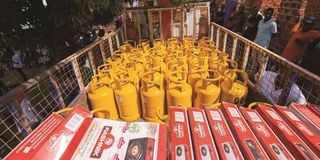Government in final stage to construct LPG handling facility

A truck carrying LPG cylinders.
The government is at the final stage in the construction of 30,000 metric tones Liquefied Petroleum Gas (LPG) handling and storage facility in Changamwe, Mombasa County.
The National Environment Management Authority (Nema) has already received an Environmental Impact Assessment (EIA)Study report from Kenya Pipeline Company (KPC) for the project which is expected to play a key role in lowering cost of gas.
“Notice to the public to submit comments on EIA Study report for the proposed LPG import, storage and handling facility located in Changamwe, Mombasa County,” read the notice.
According to the project design, the facility will primarily receive LPG from pressurised LPG ships berthed at the Sh42 billion newly constructed Kipevu Oil Terminal 2 (KOT-2) jetty using a pipeline being constructed from Common User Manifold (CUM) located next to KPC.
Already, the government has also begun converting the Kenya Petroleum Refineries Ltd (KPRL) Changamwe depot in Mombasa, a few kilometres from Kipevu, into a storage facility for fuel and LPG which will supplement the new facility.
KPC has contracted a giant Pakistani firm; Petrochem Engineering Services to design LPG import and storage facility in Changamwe, Mombasa as five private companies apply to tap into the new Kipevu Oil Terminal 2.
The facility in Mombasa once completed will quicken the loading of cooking gas for distribution by trucks which will help to cut demurrage costs.
KPC says faster loading is expected to translate to lower prices for LPG by 30 percent once operational as oil marketing companies pass the benefits of reduced demurrage costs to consumers.
“KPC proposes to install, commission and operate a 500 tonnes per day LPG truck loading facility which will enhance product evacuation and as such ease ullage constraints and subsequently reduce demurrage costs. Current LPG storage capacity in Mombasa is limited and huge demurrage is incurred by LPG ships thus affecting the final consumer price of bottled gas,” read part of KPC in tender documents.
Limited LPG storage capacity in Mombasa means that ships stay longer at the port, leading to higher demurrage costs which are then transferred to consumers thus paying high prices of bottled gas.
KPC currently receives imported LPG from ships berthed at the Shimanzi Oil Terminal and puts it into its tanks - T610 and T611 located within its Changamwe facility the product is then evacuated to local terminals through inter-connecting pipelines for truck loading and bottling respectively.
The lack of loading gantries for truck loading has been a challenge to gas companies and the facility once complete will allow companies to ferry gas in trucks which has proved to be economically viable.
With the completion of KOT2 with a capacity to connect different gas suppliers, the business which has been controlled by a few companies will end the monopoly as already five companies have applied to connect to the terminal at the port of Mombasa.
According to National Environment Management Authority (Nema) and Energy Regulatory Authority (ERC), more than five companies have applied to get license from to construct gas facilities.
Some of the companies which have applied for the license to tap in the submerged gas pipeline from KOT2 include Aevitas Investment, Mombasa Gas Terminal Limited (MGT), Lions Gate limited, Focus Container Freight Station and Mansa East Africa Limited.
Once licensed, they will cater for the untapped LPG market with the increasing population and demand in the country and in the East African region.





